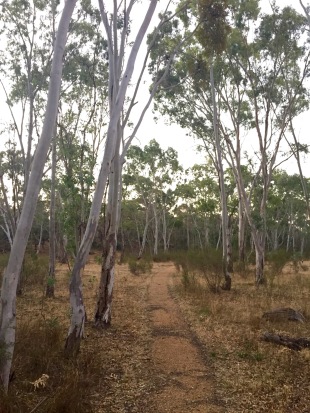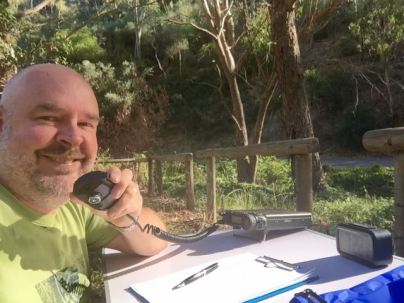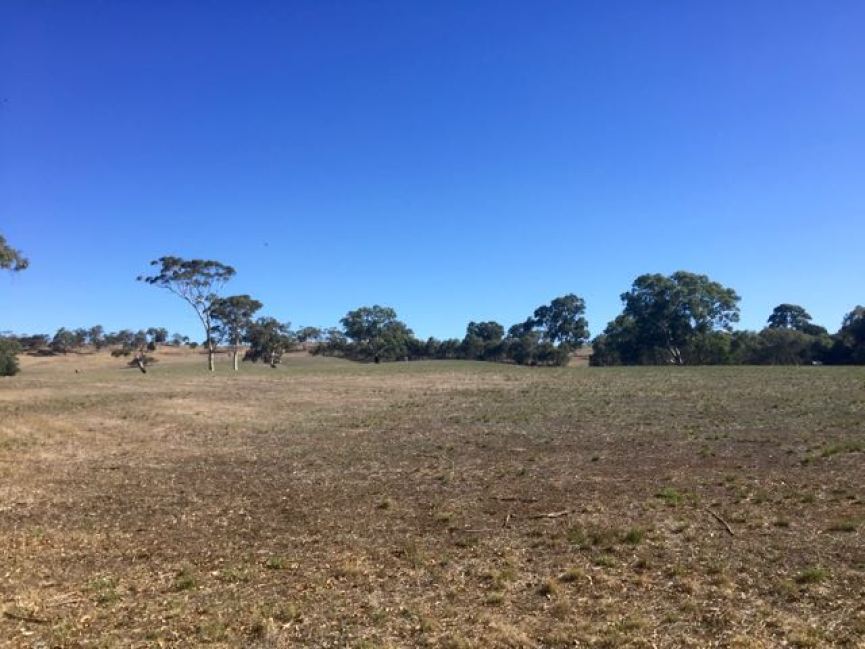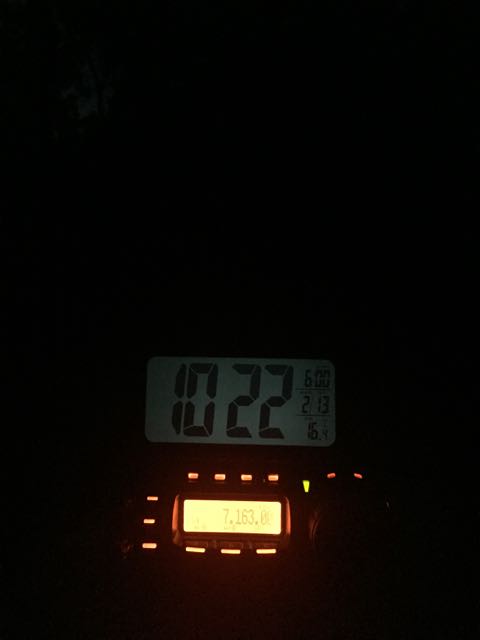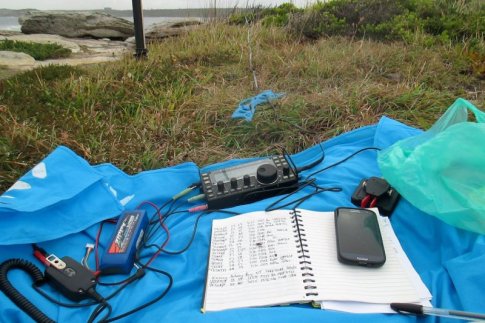Last night (Friday 26th February 2016) I activated the Kaiser Stuhl Conservation Park (CP), 5CP-097 (for the VK5 Parks Award) and VKFF-0897 (for WWFF). This was another activation for the regular Friday afternoon/evening event for the VK5 National & Conservation Parks Award.
I have activated Kaiser Stuhl CP once before. That was back in January 2014, and was with David VK5PL. But was prior to the park being added to the VKFF list for the WWFF program. So this was to be a unique park for me for VKFF. I had also arranged to meet Marcus VK3TST/5 at the park. Marcus had emailed me earlier in the day asking if he could join me.
For more information on my previous activation, check out my previous post at…..
https://vk5pas.org/2014/01/21/kaiserstuhl-conservation-park/
Kaiser Stuhl CP is about a 72 km (1 hour) drive north from home. I headed out from home via Nairne, Woodside, Charleston, and on to the historic little village of Mount Torrens. I continued on to Birdwood, the home of the National Motor Museum, and then to Mount Pleasant.

Above:- Map showing the location of the Kaiser Stuhl Conservation Park in the southern Barossa Valley. Map courtesy of Location SA Map Viewer.
After leaving Mount Pleasant I continued north to the little town of Springton. I made a small stop to take a photo of the ‘Herbig Tree’. What is the Herbig Tree I hear you ask. It is a large hollow red gum tree on the southern outskirts of the town, which was used as the home of Friedrich Herbig and his family. Friedrich migrated from The Kingdom of Prussia (now current day Germany) in 1855 and married three years later. Friedrich’s first two children were born in the tree before he built a hut nearby in 1860.
I continued on to Eden Valley, which is another historic town in the southern Barossa Valley. The town dates back to the 1950’s and contains a number of historic buildings. There is an excellent website with lots of information about Eden Valley which can be found at…..
http://www.edenvalleytourism.com.au
Whilst on my way to the park I made contact with a number of park activators including:
- Rob VK4AAC/5 in the Danggali Conservation Park
- John VK5BJE/p in the Mylor Conservation Park
- VK5HDW/p in the Furner Conservation Park
I continued along the Eden Valley Road and then turned left on to Seven Steps Road through the Flaxman Valley, which was devastated by a bushfire back in 2014. Over 25,000 hectares were burnt, and about five homes destroyed. This area is on the southern fringe of the Barossa Valley and is famous in its own right for wine production. One of my favourite wines is grown/produced here……Henschke Hill of Grace.
http://www.southaustralia.com/en/places-to-go/south-australia/wine-regions/eden-valley-wine-region

I then turned on to the Flaxmans Valley Road, and then left on to Tanunda Creek Road. The park soon came in to view on my left.

I parked the 4WD in the small area off the road and walked a short distance inside the park and started to set up my gear which consisted of the Yaesu FT-857d and the 40m/20m linked dipole supported on the 7m heavy duty squid pole. I was set up and ready to go by my nominated time of 0700 UTC (5.30 p.m. South Australian local time).

Above:- Map showing my operating spot within the park. Map courtesy of Location SA Map Viewer.
The area where the park was located was discovered in the mid 19th century by the prominent naturalists, H.H. Behr, F.J.H Von Muller, J.G.O. Tepper, and J. Menge. The Tanunda Creek Bullock Track originally crossed the creek several times within the park but was closed around 1885 in favour of the more direct route along Tanunda Creek Road. I accessed the park via Tanunda Creek Road.
A plaque within the park records the bequest to the Field Naturalists’ Society of South Australia by Mr Leo Wakem Nicholls (1894-1971). Nicholls was a keen bushwalker whose bequest to the Field Naturalists Society of S.A. enabled that organisation to contribute $30,000 towards the purchase in 1978 of the park. The official dedication ceremony took place in December, 1983.
The park includes granite features such as Horse Head Rock. Weathering and erosion have produced this rock formation which, as the name suggests, resembles a horse’s head. Capped Rock, a horizontal rock slab perched on a vertical outcrop, is another interesting feature within the park.
The park is home to native birds such as blue wrens, parrots, honeyeaters, finches and thornbills. In the late afternoon or early morning, western grey kangaroos can be seen in the open grassland areas of the park, while Euros can occasionally be seen on the rocky ridges of the higher sections of the park. Other animals to be found in the park include echidnas, possums, bats, and a variety of snakes and lizards.
About 400 plant species are supported within the park. The park was principally established to preserve the most northerly occurrence of the brown stringybark, Eucalyptus baxteri. Their multi-stemmed, mallee-like appearance is the result of earlier, regular trimming to provide wood for the Nuriootpa brick kilns.
Large blue gums, river red gums, native pines and sheoaks provide shady cover for the diverse understorey of yaccas, wattles, tea-trees and silver banksias. Many of the banksias were out in flower during my visit to the park. Many plants, such as lavender grevilleas and fringe myrtles flower in spring. The green flowered hairy correa is an unusual plant that grows in the shelter of the large granite outcrops. The rare prickly tree violet also occurs in the park and is often mistaken for the African boxthorn. This native plant provides protected nesting sites for small birds.
You may see mistletoe growing on the eucalypts, acacias and casuarinas in the park. These are parasitic native plants, which provide food and shelter for many bird species. The lichens growing on the rocks are also an important part of the ecosystem helping to weather the rocks to form soil.

I headed to 7.144 and asked if the frequency was in use, and this was responded to by Stef VK5HSX/p who was portable in the Deep Creek Conservation Park. Whilst speaking with Stef I noticed that my VSWR was up a little high and Stef reported that I was cutting in and out a little. I think I found the issue…..a dodgy BNC connection. Fortunately I was able to rectify the problem.
Stef was kind enough to hand over the frequency to me, and next up was Mick VK3PMG mobile on his way to Ballarat with a good 5/8 signal. I then had three park to park contacts in a row. First was Rob VK4AAC/5 in Danggali CP, followed by Ian VK1DI/p in the Pinnacle Nature Reserve in the ACT, and then John VK5BJE/p in the Mylor CP. All had great signals to Kaiser Stuhl.
I then called for any mobile stations, and worked Greg VK5ZGY mobile in Mount Gambier, followed by Peter VK3TKK mobile in Melbourne. I then asked for any QRP (5 watts or less) stations, and Damien VK5FDEC called in with a good 5/9 signal with his 5 watts. Next up was Greg VK5GJ at Meadows in the Adelaide Hills who was running just 4 watts (5/7 signal).
A few QSOs later I worked some more mobile stations…..Daniel VK5DJW mobile in Adelaide on his way home from work (5/9 plus), and then Rob VK3FENV mobile at Sandy Creek in Victoria. I then spoke with Les VK5KLV who was operating portable from the Winninowie Conservation Park near Port Augusta. Les always has a great signal when I hear him, and this evening was no different (5/9 plus). Next up was another mobile station. This time, Tom VK5EE who was mobile at Mount Gambier in the south east of South Australia (5/9 both ways).
A slow but steady flow of callers continued to call in, with many of those being regular park hunters for both WWFF and the VK5 Parks Award. There was good representation from across Australia, with calls from VK2, VK3, VK4, VK5, and VK7. I did start to experience a little bit of QRM from some European stations on the same frequency, but as signals were so strong, there was no difficulty in copying anyone.
It was at this time that Marcus VK3TST/5 arrived at the park and I took the opportunity of having a chat to Marcus as the callers had started to slow down. I checked out Marcus’ QRP home brew double side band transceiver. Whilst Marcus and I were talking we heard the voice of Jonathan VK6JON calling CQ on 7.144. I was aware that Jonathan was going to be heading out to a park, so I quickly rushed to the mic and gave him a call. Although Jonathan’s signal was down, he was still very readable (5/1). But this didn’t last, as the European QRM picked up and Jonathan’s signal disappeared. But we had made it, exchanging signal reports.
Marcus then starting setting up, trying to get his antenna up in the air, with great difficulty. After numerous attempts, we resorted in getting out my spare squid pole from the car.

After working a total of 41 stations on 40m I lowered the squid pole and removed the links and headed to 14.310. The frequency sounded clear and I was about to ask if the frequency was in use, when I heard Rick VK4RF come back to Stef VK5HSX/p. Unfortunately I was unable to hear Stef in the Deep Creek Conservation Park. He was just too close for 20m propagation. So I headed up to 14.315 but there was a large pile up going. Not sure who it was. So I then went down to 14.300 but there was a pulsing noise on the frequency, which I suspect to be some sort of Over the Horizon Radar (OTHR). So down lower I went to 14.295 and asked if the frequency was in use.
First taker there was Jonathan VK6JON/p in the William Bay National Park, who was much stronger than he was on 40m. Marcus also spoke with Jonathan, and then continued to set up his station. Rick VK4RF/VK4HA had been patiently waiting on the side, so I worked Rick and also allowed him in to get Jonathan in the log as well. Rick was pounding in with a 5/9 plus signal

Marcus VK3TST talking to VK6JON
Rick VK4RF was kind enough to spot me on parksnpeaks and the DX Cluster, and we spoke briefly about the hope of getting some DX in the log. AFter finishing up with Rick, I then heard a very strong signal, ask “Paul, am I DX?” It was my old mate Ted VK6NTE with his normal very very strong signal from Western Australia. This was followed by a call from Greg VK8KMD from Alice Springs, who was substantially off frequency. I twirled the VFO to keep chasing Greg, who unfortunately was struggling with my signal. Ian VK6DW then called in with a beautiful 5/9 signal from Perth, and my last contact on 20m was with Ray VK4NH/6 in the shack of VK6NTE.
Despite a number of CQ calls I had no further takers and no DX. What a difference a day makes. Yesterday I worked a large pile up from home, long path into Europe. This lasted for 2 hours and I went QRT at 8.30 p.m. local time so I could have a very late tea. Admittedly that was with 100 watts and my 5 element yagi, and from Kaiser Stuhl I was running just 40 watts and a small dipole.
Marcus and I continued to chat away, and next up I tried calling CQ on 21.244 on 15m. Unfortunately I had no mobile phone coverage and was not able to spot on parksnpeaks. A quick tune across the 15m band revealed no signals.
It was not just after 8.00 p.m. and as I was unable to get a message back home to my wife that I was safe in the park, I decided to pack up.
I had a total of 48 contacts in the log for my activation of Kaiser Stuhl CP.
The following stations were worked on 40m SSB:-
- VK5HSX/p (Deep Creek Conservation Park)
- VK3PMG/m
- VK4AAC/5 (Danggali Conservation Park)
- VK1DI/p (Pinnacle Nature Reserve)
- VK5BJE/p (Mylor Conservation Park)
- VK5ZGY/m
- VK3TKK/m
- VK5FDEC
- VK5GJ
- VK5NRG
- VK2HHA
- VK5DJW/m
- VK3FENV/m
- VK5KPR
- VK5AV
- VK5KLV/p (Winninowie Conservation Park)
- VK5EE/m
- VK5PL
- VK2YK
- VK4RF
- VK4HA
- VK3PF
- VK3BFR
- VK3HXT
- VK2RM
- VK2NWB
- VK3KRH
- VK7LTD
- VK3CFA
- VK3YW
- VK3VIN
- VKPKT
- VK4FR/5
- VK3PAT
- VK2NP
- VK3FSPG
- VK1MTS
- VK7FGGT
- VK5YX
- VK5ZLT/3
- VK6JON/p (William Bay National Park)
The following stations were worked on 20m SSB:-
- VK6JON/p (William Bay National Park)
- VK4RF
- VK4HA
- VK6NTE
- VK8KMD
- VK6DW
- VK4NH/6
This was good timing anyway, as the 7130 DX Net had started and Marcus was tuning in to it. We decided that I would get mobile, book in to the net and let Roy Vk7ROY, the Net Control, know that Marcus was there. And this is exactly what I did.
I became mobile and booked in to the Net. Roy VK7ROY was very strong. I told Roy that Marcus was in the park and running QRP 2 watts. Roy then gave Marcus a call, and the rest is history. Marcus made a number of contacts on the net, as did I from the mobile on my way home. This included the following….
- Marcus VK3TST/p
- FO5JV in French Polynesia
- NR6Q in California USA
- VK7VEK
- KG7JWD in Washington USA
- VK4FFAB
- VK2RI
- K9RM in Indiana USA
- ZL2ASH
- K1GUN in Maine USA
- VO1NO/VE1 in Canada.
References.
‘Kaisertstuhl Conservation Park’ brochure, Department of Environment and Natural Resources.
National Parks South Australia, 2016, <http://www.environment.sa.gov.au/parks/Find_a_Park/Browse_by_region/Barossa/Kaiserstuhl_Conservation_Park>, viewed 27th February 2016











